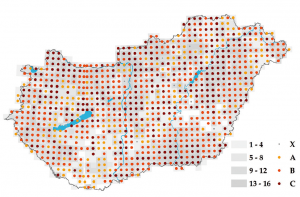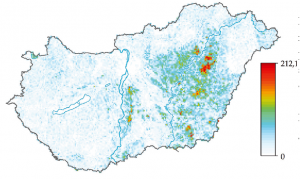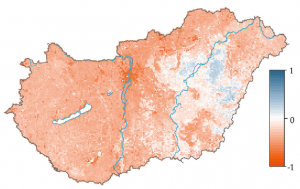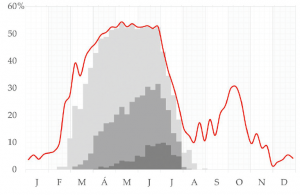Bird Atlas of Hungary published
December 2, 2021
In 2014, BirdLife Hungary (MME) started the MAP (Madár Atlasz Program) program to ensure the requirement of data gathering for the second European Breeding Bird Atlas (EBBA2). We aimed to collect data for preparing the first Hungarian Bird Atlas that summarizes all available knowledge about the population, distribution, population dynamics and conservation status of 420 bird species that occurred naturally in Hungary until 2019. As a result, we published the Bird Atlas of Hungary at the end of September 2021.
We based the fieldwork of the MAP program on a survey in 2.5 x 2.5 km UTM squares during 2014–2018. We collected the occurrence data and breeding evidence code of species, basic information of each survey (date, time, duration, area covered, identification skills of the observer). In total, we gained 15 808 surveys with complete lists, covering 6756 squares. More than a thousand observers contributed to the fieldwork. In the case of rare species, we considered data until the end of 2019.
The Atlas presents the distribution of each breeding species using the 10 x 10 km UTM grids and modelled probability of presence in the country in a 2 x 2 km grid, based on modelling with observation related (date, time, duration, coverage, identification skill), habitat, climate, soil and altitude values by random forest method. In addition, we carried out various modelled maps with the random forest using TRIM maps, an R-based program package.
We used the same 2.5 x 2.5 km UTM grid in the MAP program as in the Hungarian Common Bird Monitoring program (Mindennapi Madaraink Monitoringja, MMM), based on random sampling and running since 1999. This method lets us consider the available relative density data from 2014–2018 to model and produce a map of relative density for common breeding species. Based on the MMM program, a survey of breeding and wintering populations running since 1999, we present population trends for common breeding and wintering species for the 1999–2018 period. The Atlas shows modelled trend index map based on the change of relative density between 1999–2003 and 2014–2018 by the MMM program in several common breeding and wintering species. Dot maps of rare species show sites of all documented records. For each species, a figure presents the temporal distribution of observation probability and breeding evidence within a year, based on data from 2014–2018. Finally, we offer the population size estimation for each species: 1 – using population estimates of presence/relative density modelling by TRIM maps for common species, 2 – direct counts of properly monitored and colonial species, 3 – expert assessment for rare, hidden and data deficient species.
In total, 64 authors wrote methodological, short analytical and species chapters with 1,700 maps and graphs, giving the complete picture of the situation of wild birds of Hungary in a book spanning 800 pages.
An English summary of Atlas’s background, methods, and main general results are given. A short English summary at the end of each species chapter and English titles/descriptions of all maps, figures, and tables.
The bird atlas of Hungary is not currently available commercially. However, the whole book can be read in a digital form online with links to tables summarizing the results and the data related to data collection and modelling (downloadable pdf).
Szép T., Csörgő T., Halmos G., Lovászi P., Nagy K. & Schmidt A. (eds.) 2021. Magyarország madáratlasza. [Bird Atlas of Hungary] – Agrárminisztérium, Magyar Madártani és Természetvédelmi Egyesület, Budapest.
Tibor Szép
University of Nyíregyháza & MME/BirdLife Hungary
Sample maps of the Eurasian Skylark (Alauda arvensis)

Map of breeding evidence of the Eurasian Skylark.
A: probable breeding, B: possible breeding, C: confirmed breeding, X: no breeding; Greyscale: intensity of survey

Predicted presence of the Eurasian Skylark in the breeding season.

Modelled relative density of the Eurasian Skylark in the breeding season (individual/km2).

The trend of the breeding population of the Eurasian Skylark in Hungary between 1999–2018.

Trend index map of the Eurasian Skylark breeding population between 1999–2003 and 2014–2018.

Frequency of observation probability and breeding evidence of the Eurasian Skylark (letters: abbreviation of months).

